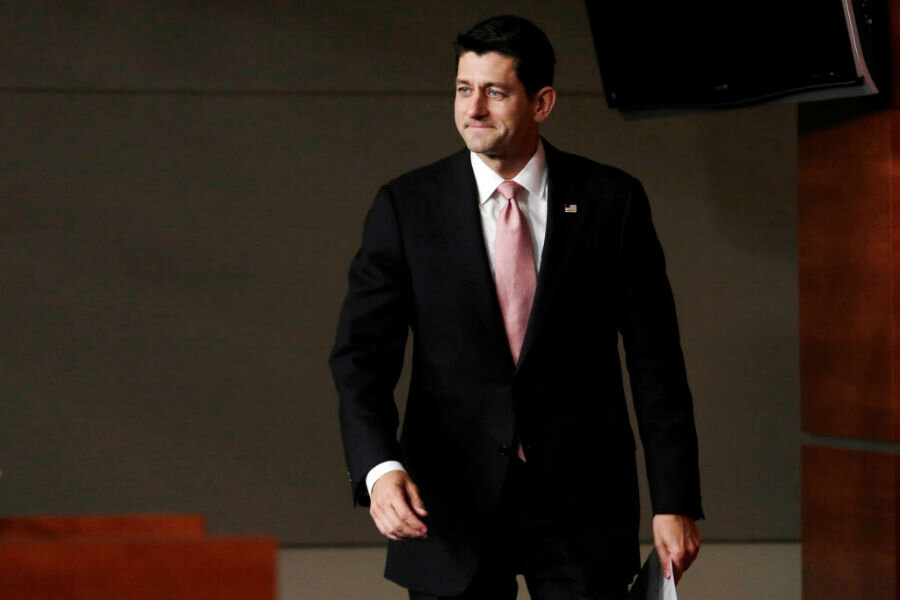Ryan's rewrite of the tax code
Loading...
House Speaker Paul Ryan (R-WI) unveiled his long-promised rewrite of the tax code Thursday. The plan, which he says represents the consensus view of his Republican caucus, contemplates a substantial tax cut for businesses and many individuals, especially investors and high-income households. It would take a big step towards a business cash flow tax. Its business rate cuts would be dramatic, its individual rate cuts less so—especially for middle-income taxpayers. It would dump some targeted individual tax breaks, but retain most of the biggest and most popular.
Ryan claims that “no income group will see an increase in its Federal tax burden” and that the plan would raise roughly the same amount of money as the current tax code. Accomplishing both of these goals requires the authors to assume that 1) the plan would create significant economic growth and 2) the current code’s revenue baseline includes $400 billion in tax cuts that are scheduled to expire.
The Tax Policy Center has not formally estimated either the revenue or distributional effects of the proposal. But it is hard to imagine how these tax cuts could pay for themselves.
Tax Reform Details
Here’s what Ryan’s plan would do for households: Collapse the current seven-rate individual tax system to three rates: 12-25-33 percent. Roughly double the current standard deduction and personal exemption to $24,000 for joint filers ($12,000 for singles). Retain a revised child credit and some form of earned income credit (EITC).
It would also repeal the individual Alternative Minimum Tax and the estate and gift tax. It would scrap the state and local tax deduction and most smaller deductions and credits, but keep deductions for mortgage interest and charitable giving, as well as tax preferences to encourage savings for retirement and higher education, and for buying health insurance. Half of investment income would be tax-free. The rest would be taxed at ordinary income rates, effectively setting a top rate on capital gains, dividends, and interest of 16.5 percent.
Here’s what he’d do for business: Pass-through firms such as partnerships would be taxed at up to 25 percent. Corporations would be taxed at 20 percent. Firms could expense all capital investment but could no longer deduct net interest costs (they could continue to deduct interest expense to the extent they have interest income). Most other business preferences would be repealed, except for a research credit. Current Net Operating Losses could be carried forward indefinitely. U.S. based multinationals would be subject to U.S. tax only on U.S. income. Accumulated foreign earnings held in cash would be taxed at 8.75 percent. Earnings held in other forms would be taxed at 3.5 percent.
Yet, this is not really a policy proposal—it leaves much too much to the imagination for that. It is instead a political document—a tool Ryan wants House Republicans to use in their fall campaigns.
It does raise some interesting policy issues. It takes steps towards a consumption tax, though it conspicuously insists “This blueprint does not include a value-added tax…or any other tax as an addition to the fundamental reforms of the current income tax system.” As with other recent GOP tax proposals, the lady protests too much.
It also would simplify the code in many important respects and, by dumping many special interest and targeted tax breaks, has the potential the make the code more efficient. Yet, it also ducks many tough questions and leaves it to the Ways & Means Committee to figure out how to revise deductions for mortgage interest and charitable gifts, savings incentives for retirement and higher education, and the EITC.
In a separate health reform plan released earlier this week. Ryan and his caucus also said they’d retain (but cap) the exclusion for employee sponsored health insurance, make health savings accounts more generous, and create an unspecified new tax credit to subsidy the cost of health insurance.
Importantly, it also acknowledges that deep individual rate cuts, the Holy Grail of Republicans for decades, may not be quite as easy as some think. A 33 percent top rate is far from GOP Nirvana.
The Trump Connection
As a political document, the plan seems tone-deaf. At a time when populist fever is running high, Ryan is proposing significant tax cuts for big business and investors, and much more modest tax cuts for middle-income households. And it is hard to see what candidates running on a ticket with Donald Trump would do with this plan.
Trump, because he is Trump, has been able to sell his blue-collar backers on the benefits of tax cuts aimed at high-income taxpayers. I’m not sure that a typical congressman will have the same success. And, in the details, the differences between this plan and Trump’s plan are striking. The House Republicans’ proposed top individual rate is 33 percent. His is 25 percent. They’d tax corporations at 25 percent. He’d tax them at 15 percent. They’d move to a territorial tax system. He would not.
If he wanted anyone to pay attention, Ryan could not have picked a worse day to roll out his plan. Not only is it a summer Friday, but it is two days after Ryan abruptly adjourned the House for two weeks in the face of a raucous protest by House Democrats over gun control, and the day the British voted to leave the European Union. Not many will notice this plan. Maybe that’s what he had in mind.
This article is first appeared at TaxVox.







